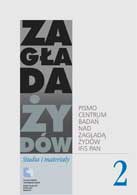Menu
- Main Page
- About us
- Research
- Publications
- Links
- Contact
- Archiwum
- Holocaust. Studies and Materials
the Center's Journal - NIGHT WITHOUT AND END - »FAILED CORRECTION«
- Wybór źródeł
- EHRI PL
News
Programme of Center's academic seminars for winter term 2025
We are pleased to announce the return of our scientific seminar series in less than a month, and warmly invite all interested parties to attend. The seminars will be held on the second or third Wednesday of each month, both in person at the Institute of Philosophy and Sociology of the Polis...
M. Turski Historical Award of Polityka for Justyna Majewska
It is with undisguised pride we report that our colleague Dr. Justyna Majewska has been awarded the Marian Turski POLITYKA Historical Prize for her book debut, "Mury i szczeliny. Przestrzenie getta warszawskiego /Walls and Slits. Spaces of the Warsaw Ghetto". We are very happy and...
Call for Articles - Holocaust Studies and Materials 2026
Call for Articles 2026 Call for Articles Connecting scholarly reflection on the Holocaust to the present - new sources and technologies in research The past decade has seen a breakthrough in Holocaust research, both in terms of the availability of archival sources and the digital ...
Farewell to Marian Turski
It is with profound sorrow that we bid farewell to Marian Turski—a distinguished journalist, historian, and Survivor. An extraordinary man whose voice resonated deeply, he not only shared the lessons of the past but actively championed courage, solidarity, and empathy in the face of evil. ...
Center in EHRI PL consortium
Polish Center for Holocaust Research of the Institute of Philosophy and Sociology of the Polish Academy of Sciences, together with the E. Ringelblum Jewish Historical Institute and the Center for Jewish Studies of the University of Lodz, are creating a national node of the European Holocaust Research Infrastructure within the framework of ERIC
NEWSLETTER
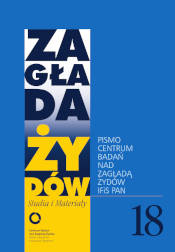 Zagłada Żydów.
Zagłada Żydów.
Studia i Materiały
nr 18, R. 2022
Warszawa 2022
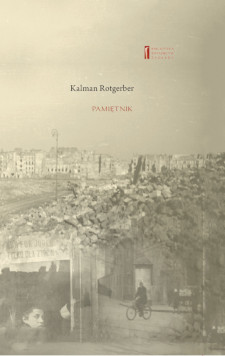 PAMIĘTNIK
PAMIĘTNIK
Kalman Rotgeber
oprac. Aleksandra Bańkowska, wstęp Jacek Leociak
Warszawa 2021
Zagłada Żydów.
Studia i Materiały
nr 17, R. 2021
Warszawa 2021
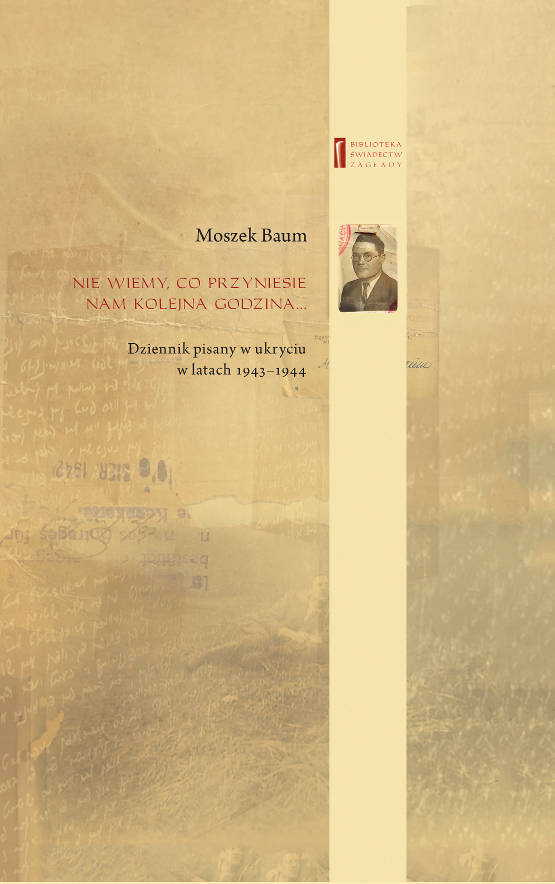 NIE WIEMY CO PRZYNIESIE NAM KOLEJNA GODZINA ...
NIE WIEMY CO PRZYNIESIE NAM KOLEJNA GODZINA ...
Dziennik pisany w ukryciu w latach 1943-1944
Moszek Baum, oprac. Barbara Engelking, tłum. z jidysz Monika Polit
Warszawa 2020
Zagłada Żydów.
Studia i Materiały
nr 16, R. 2020
Warszawa 2020
.jpg) Aryjskiego Żyda wspomnienia, łzy i myśli
Aryjskiego Żyda wspomnienia, łzy i myśli
Zapiski z okupacyjnej Warszawy
Sewek Okonowski, oprac. Marta Janczewska
 PISZĄCY TE SŁOWA JEST PRACOWNIKIEM
PISZĄCY TE SŁOWA JEST PRACOWNIKIEM
GETTOWEJ INSTYTUCJI ...
'z Dziennika' i inne pisma z łódzkiego getta
Józef Zelkowicz, tłum. z jidysz, oprac. i wstęp. Monika Polit
Warszawa 2019
CZYTAJĄC GAZETĘ NIEMIECKĄ ...
Dziennik pisany w ukryciu w Warszawie w latach 1943-1944
Jakub Hochberg, oprac. i wstępem opatrzyła Barbara Engelking
Warszawa 2019
Zagłada Żydów.
Studia i Materiały
nr 15, R. 2019
Warszawa 2019
.jpg) Zagłada Żydów.
Zagłada Żydów.
Studia i Materiały
nr 14, R. 2018
Warszawa 2018
 DALEJ JEST NOC. Losy Żydów w wybranych powiatach okupowanej Polski
DALEJ JEST NOC. Losy Żydów w wybranych powiatach okupowanej Polski
red. i wstęp Barbara Engelking, Jan Grabowski
Warszawa 2018
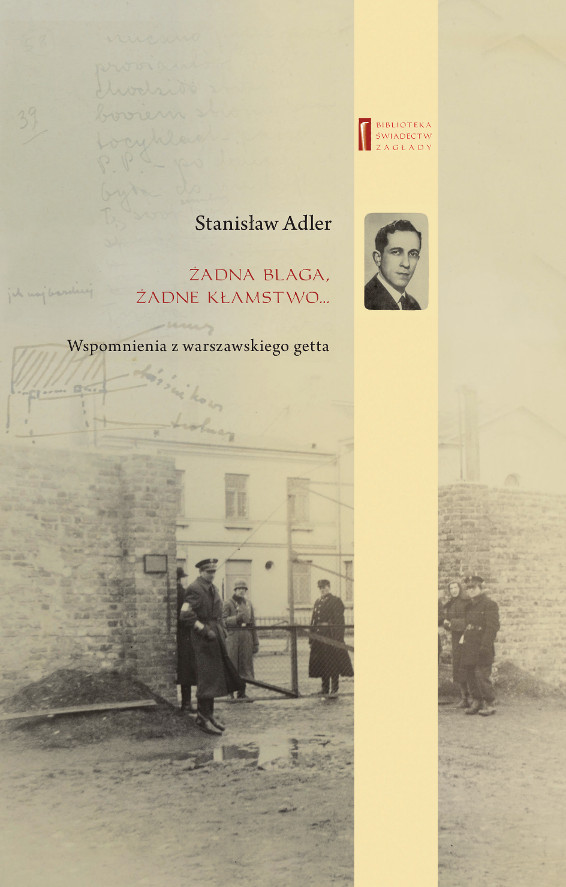 ŻADNA BLAGA, ŻADNE KŁAMSTWO ...
ŻADNA BLAGA, ŻADNE KŁAMSTWO ...
Wspomnienia z warszawskiego getta
Stanisław Adler, oprac. i wstępem opatrzyła Marta Janczewska
Warszawa 2018
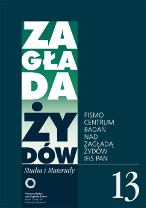 Zagłada Żydów.
Zagłada Żydów.
Studia i Materiały
nr 13, R. 2017
Warszawa 2017
 TYLEŚMY JUŻ PRZESZLI ...
TYLEŚMY JUŻ PRZESZLI ...
Dziennik pisany w bunkrze (Żółkiew 1942-1944)
Clara Kramer, oprac. i wstępem opatrzyła Anna Wylegała
Warszawa 2017
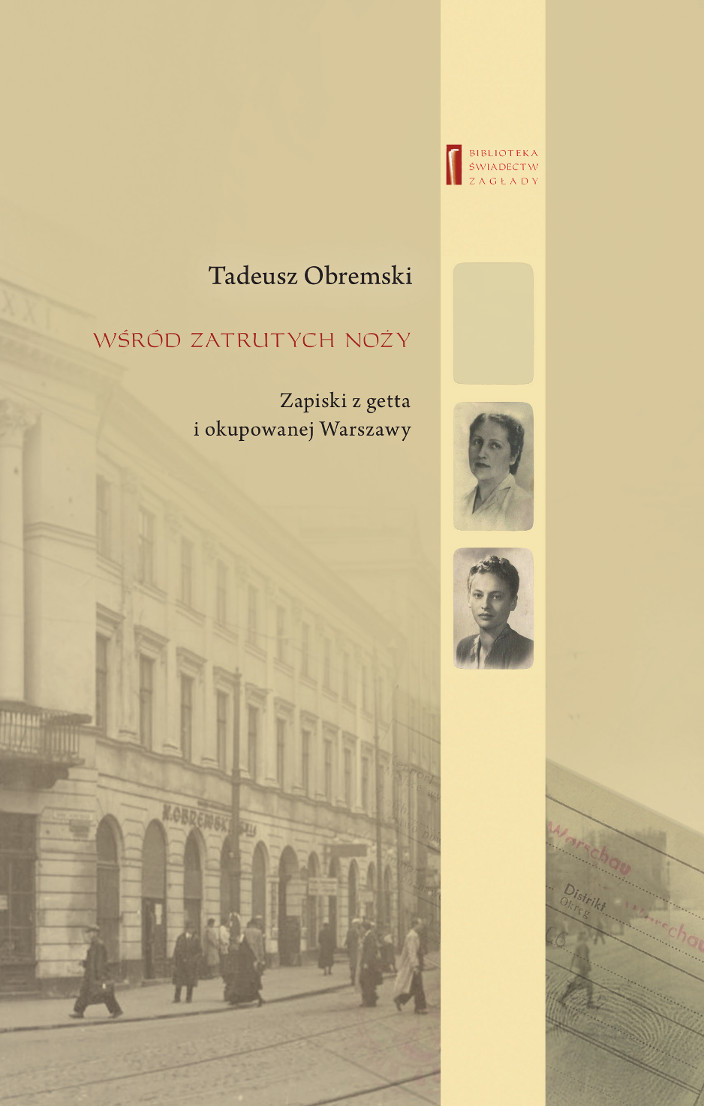 WŚRÓD ZATRUTYCH NOŻY ...
WŚRÓD ZATRUTYCH NOŻY ...
Zapiski z getta i okupowanej Warszawy
Tadeusz Obremski, oprac. i wstępem opatrzyła Agnieszka Haska
Warszawa 2017
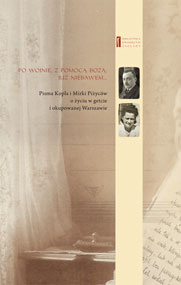 PO WOJNIE, Z POMOCĄ BOŻĄ, JUŻ NIEBAWEM ...
PO WOJNIE, Z POMOCĄ BOŻĄ, JUŻ NIEBAWEM ...
Pisma Kopla i Mirki Piżyców o życiu w getcie i okupowanej Warszawie
oprac. i wstępem opatrzyła Barbara Engelking i Havi Dreifuss
Warszawa 2017
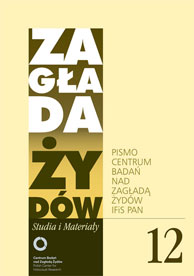 Zagłada Żydów.
Zagłada Żydów.
Studia i Materiały
nr 12, R. 2016
Warszawa 2016
.jpg) SNY CHOCIAŻ MAMY WSPANIAŁE ...
SNY CHOCIAŻ MAMY WSPANIAŁE ...
Okupacyjne dzienniki Żydów z okolic Mińska Mazowieckiego
oprac. i wstępem opatrzyła Barbara Engelking
Warszawa 2016
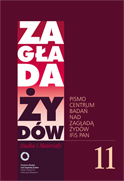 Zagłada Żydów.
Zagłada Żydów.
Studia i Materiały
nr 11, R. 2015
Warszawa 2015
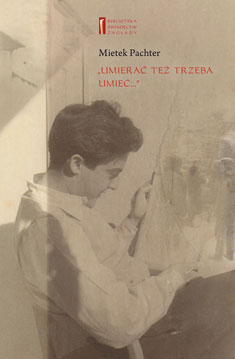 Mietek Pachter
Mietek Pachter
UMIERAĆ TEŻ TRZEBA UMIEĆ ...
oprac. B. Engelking
Warszawa 2015
 Zagłada Żydów.
Zagłada Żydów.
Studia i Materiały
nr 10, t. I-II, R. 2014
Warszawa 2015
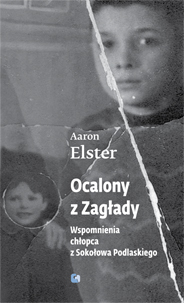 OCALONY Z ZAGŁADY
OCALONY Z ZAGŁADY
Wspomnienia chłopca z Sokołowa Podlaskiego
tłum. Elżbieta Olender-Dmowska
red .B. Engelking i J. Grabowski
Warszawa 2014
 ZAGŁADA ŻYDÓW. STUDIA I MATERIAŁY
ZAGŁADA ŻYDÓW. STUDIA I MATERIAŁY
vol. 9 R. 2013
Pismo Centrum Badań nad Zagładą Żydów IFiS PAN
Warszawa 2013
 ... TĘSKNOTA NACHODZI NAS JAK CIĘŻKA CHOROBA ...
... TĘSKNOTA NACHODZI NAS JAK CIĘŻKA CHOROBA ...
Korespondencja wojenna rodziny Finkelsztejnów, 1939-1941
oprac. i wstępem opatrzyła Ewa Koźmińska-Frejlak
Warszawa 2012
Raul Hilberg
PAMIĘĆ I POLITYKA. Droga historyka Zagłady
tłum. Jerzy Giebułtowski
Warszawa 2012
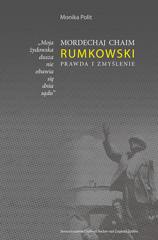 Monika Polit
Monika Polit
"Moja żydowska dusza nie obawia się dnia sądu."
Mordechaj Chaim Rumkowski. Prawda i zmyślenie
Warszawa 2012
.jpg) Dariusz Libionka i Laurence Weinbaum
Dariusz Libionka i Laurence Weinbaum
Bohaterowie, hochsztaplerzy, opisywacze. Wokół Żydowskiego Związku Wojskowego
Warszawa 2011
.jpg) Zagłada Żydów.
Zagłada Żydów.
Studia i Materiały
R. 2011, nr. 7; Warszawa 2011
.jpg) Jan Grabowski
Jan Grabowski
JUDENJAGD. Polowanie na Żydów 1942.1945.
Studium dziejów pewnego powiatu
Warszawa 2011
.jpg) Stanisław Gombiński (Jan Mawult)
Stanisław Gombiński (Jan Mawult)
Wspomnienia policjanta z warszawskiego getta
oprac. i wstęp Marta Janczewska
Warszawa 2010
Holocaust Studies and Materials
Journal of the Polish Center for Holocaust Research
Warssaw 2010
.jpg) Żydów łamiących prawo należy karać śmiercią!
Żydów łamiących prawo należy karać śmiercią!
"Przestępczość" Żydów w Warszawie, 1939-1942
B. Engelking, J. Grabowski
Warszawa 2010
Zagłada Żydów.
Studia i Materiały
R. 2010, nr. 6; Warszawa 2010
Wybór źródeł do nauczania o zagładzie Żydów
Ćwiczenia ze źródłami
red. A. Skibińska, R. Szuchta
Warszawa 2010
.jpg) W Imię Boże!
W Imię Boże!
Cecylia Gruft
oprac. i wstęp Łukasz Biedka
Warszawa 2009
Zagłada Żydów.
Studia i Materiały
R. 2009, nr. 5; Warszawa 2009
.jpg) Żydzi w powstańczej Warszawie
Żydzi w powstańczej Warszawie
Barbara Engelking i Dariusz Libionka
Warszawa 2009
 Reportaże z warszawskiego getta
Reportaże z warszawskiego getta
Perec Opoczyński
Warszawa 2009
 Notatnik
Notatnik
Szmul Rozensztajn
Warszawa 2008
.jpg) Holocaust
Holocaust
Studies and Materials.
English edition
2008, vol. 1; Warsaw 2008
.jpg) Źródła do badań nad zagładą Żydów na okupowanych ziemiach polskich
Źródła do badań nad zagładą Żydów na okupowanych ziemiach polskich
Przewodnik archiwalno-bibliograficzny
Alina Skibińska, wsp. Marta Janczewska, Dariusz Libionka, Witold Mędykowski, Jacek Andrzej Młynarczyk, Jakub Petelewicz, Monika Polit
Warszawa 2007
Zagłada Żydów. Studia i Materiały
R. 2007, nr. 3; Warszawa 2007
Prowincja noc.
Życie i zagłada Żydów w dystrykcie warszawskim
Warszawa 2007
.jpg) Utajone miasto.
Utajone miasto.
Żydzi po 'aryjskiej' stronie Warszawy [1941-1944]
Gunnar S Paulsson
Kraków 2007
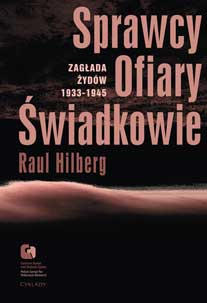 Sprawcy, Ofiary, Świadkowie.
Sprawcy, Ofiary, Świadkowie.
Zagłada Żydów, 1933-1944
Raul Hilberg
Warszawa 2007
Zagłada Żydów. Studia i Materiały
R. 2006, nr. 2; Warszawa 2006
"Jestem Żydem, chcę wejść!".
Hotel Polski w Warszawie, 1943.
Agnieszka Haska
Warszawa 2006
Zagłada Żydów. Studia i Materiały
R. 2005, nr. 1; Warszawa 2005
.jpg) 'Ja tego Żyda znam!'
'Ja tego Żyda znam!'
Szantażowanie Żydów w Warszawie, 1939-1943.
Jan Grabowski
Warszawa 2004
 'Szanowny panie Gistapo!'
'Szanowny panie Gistapo!'
Donosy do władz niemieckich w Warszawie i okolichach, 1940-1941
Barbara Engelking, Warszawa 2003
aaa
 Zagłada Żydów.
Zagłada Żydów.
Studia i Materiały
nr 18, R. 2022
Warszawa 2022
 PAMIĘTNIK
PAMIĘTNIK
Kalman Rotgeber
oprac. Aleksandra Bańkowska, wstęp Jacek Leociak
Warszawa 2021
Zagłada Żydów.
Studia i Materiały
nr 17, R. 2021
Warszawa 2021
 NIE WIEMY CO PRZYNIESIE NAM KOLEJNA GODZINA ...
NIE WIEMY CO PRZYNIESIE NAM KOLEJNA GODZINA ...
Dziennik pisany w ukryciu w latach 1943-1944
Moszek Baum, oprac. Barbara Engelking, tłum. z jidysz Monika Polit
Warszawa 2020
Zagłada Żydów.
Studia i Materiały
nr 16, R. 2020
Warszawa 2020
.jpg) Aryjskiego Żyda wspomnienia, łzy i myśli
Aryjskiego Żyda wspomnienia, łzy i myśli
Zapiski z okupacyjnej Warszawy
Sewek Okonowski, oprac. Marta Janczewska
 PISZĄCY TE SŁOWA JEST PRACOWNIKIEM
PISZĄCY TE SŁOWA JEST PRACOWNIKIEM
GETTOWEJ INSTYTUCJI ...
'z Dziennika' i inne pisma z łódzkiego getta
Józef Zelkowicz, tłum. z jidysz, oprac. i wstęp. Monika Polit
Warszawa 2019
CZYTAJĄC GAZETĘ NIEMIECKĄ ...
Dziennik pisany w ukryciu w Warszawie w latach 1943-1944
Jakub Hochberg, oprac. i wstępem opatrzyła Barbara Engelking
Warszawa 2019
Zagłada Żydów.
Studia i Materiały
nr 15, R. 2019
Warszawa 2019
.jpg) Zagłada Żydów.
Zagłada Żydów.
Studia i Materiały
nr 14, R. 2018
Warszawa 2018
 DALEJ JEST NOC. Losy Żydów w wybranych powiatach okupowanej Polski
DALEJ JEST NOC. Losy Żydów w wybranych powiatach okupowanej Polski
red. i wstęp Barbara Engelking, Jan Grabowski
Warszawa 2018
 ŻADNA BLAGA, ŻADNE KŁAMSTWO ...
ŻADNA BLAGA, ŻADNE KŁAMSTWO ...
Wspomnienia z warszawskiego getta
Stanisław Adler, oprac. i wstępem opatrzyła Marta Janczewska
Warszawa 2018
 Zagłada Żydów.
Zagłada Żydów.
Studia i Materiały
nr 13, R. 2017
Warszawa 2017
 TYLEŚMY JUŻ PRZESZLI ...
TYLEŚMY JUŻ PRZESZLI ...
Dziennik pisany w bunkrze (Żółkiew 1942-1944)
Clara Kramer, oprac. i wstępem opatrzyła Anna Wylegała
Warszawa 2017
 WŚRÓD ZATRUTYCH NOŻY ...
WŚRÓD ZATRUTYCH NOŻY ...
Zapiski z getta i okupowanej Warszawy
Tadeusz Obremski, oprac. i wstępem opatrzyła Agnieszka Haska
Warszawa 2017
 PO WOJNIE, Z POMOCĄ BOŻĄ, JUŻ NIEBAWEM ...
PO WOJNIE, Z POMOCĄ BOŻĄ, JUŻ NIEBAWEM ...
Pisma Kopla i Mirki Piżyców o życiu w getcie i okupowanej Warszawie
oprac. i wstępem opatrzyła Barbara Engelking i Havi Dreifuss
Warszawa 2017
 Zagłada Żydów.
Zagłada Żydów.
Studia i Materiały
nr 12, R. 2016
Warszawa 2016
.jpg) SNY CHOCIAŻ MAMY WSPANIAŁE ...
SNY CHOCIAŻ MAMY WSPANIAŁE ...
Okupacyjne dzienniki Żydów z okolic Mińska Mazowieckiego
oprac. i wstępem opatrzyła Barbara Engelking
Warszawa 2016
 Zagłada Żydów.
Zagłada Żydów.
Studia i Materiały
nr 11, R. 2015
Warszawa 2015
 Mietek Pachter
Mietek Pachter
UMIERAĆ TEŻ TRZEBA UMIEĆ ...
oprac. B. Engelking
Warszawa 2015
 Zagłada Żydów.
Zagłada Żydów.
Studia i Materiały
nr 10, t. I-II, R. 2014
Warszawa 2015
 OCALONY Z ZAGŁADY
OCALONY Z ZAGŁADY
Wspomnienia chłopca z Sokołowa Podlaskiego
tłum. Elżbieta Olender-Dmowska
red .B. Engelking i J. Grabowski
Warszawa 2014
 ZAGŁADA ŻYDÓW. STUDIA I MATERIAŁY
ZAGŁADA ŻYDÓW. STUDIA I MATERIAŁY
vol. 9 R. 2013
Pismo Centrum Badań nad Zagładą Żydów IFiS PAN
Warszawa 2013
 ... TĘSKNOTA NACHODZI NAS JAK CIĘŻKA CHOROBA ...
... TĘSKNOTA NACHODZI NAS JAK CIĘŻKA CHOROBA ...
Korespondencja wojenna rodziny Finkelsztejnów, 1939-1941
oprac. i wstępem opatrzyła Ewa Koźmińska-Frejlak
Warszawa 2012
Raul Hilberg
PAMIĘĆ I POLITYKA. Droga historyka Zagłady
tłum. Jerzy Giebułtowski
Warszawa 2012
 Monika Polit
Monika Polit
"Moja żydowska dusza nie obawia się dnia sądu."
Mordechaj Chaim Rumkowski. Prawda i zmyślenie
Warszawa 2012
.jpg) Dariusz Libionka i Laurence Weinbaum
Dariusz Libionka i Laurence Weinbaum
Bohaterowie, hochsztaplerzy, opisywacze. Wokół Żydowskiego Związku Wojskowego
Warszawa 2011
.jpg) Zagłada Żydów.
Zagłada Żydów.
Studia i Materiały
R. 2011, nr. 7; Warszawa 2011
.jpg) Jan Grabowski
Jan Grabowski
JUDENJAGD. Polowanie na Żydów 1942.1945.
Studium dziejów pewnego powiatu
Warszawa 2011
.jpg) Stanisław Gombiński (Jan Mawult)
Stanisław Gombiński (Jan Mawult)
Wspomnienia policjanta z warszawskiego getta
oprac. i wstęp Marta Janczewska
Warszawa 2010
Holocaust Studies and Materials
Journal of the Polish Center for Holocaust Research
Warssaw 2010
.jpg) Żydów łamiących prawo należy karać śmiercią!
Żydów łamiących prawo należy karać śmiercią!
"Przestępczość" Żydów w Warszawie, 1939-1942
B. Engelking, J. Grabowski
Warszawa 2010
Zagłada Żydów.
Studia i Materiały
R. 2010, nr. 6; Warszawa 2010
Wybór źródeł do nauczania o zagładzie Żydów
Ćwiczenia ze źródłami
red. A. Skibińska, R. Szuchta
Warszawa 2010
.jpg) W Imię Boże!
W Imię Boże!
Cecylia Gruft
oprac. i wstęp Łukasz Biedka
Warszawa 2009
Zagłada Żydów.
Studia i Materiały
R. 2009, nr. 5; Warszawa 2009
.jpg) Żydzi w powstańczej Warszawie
Żydzi w powstańczej Warszawie
Barbara Engelking i Dariusz Libionka
Warszawa 2009
 Reportaże z warszawskiego getta
Reportaże z warszawskiego getta
Perec Opoczyński
Warszawa 2009
 Notatnik
Notatnik
Szmul Rozensztajn
Warszawa 2008
.jpg) Holocaust
Holocaust
Studies and Materials.
English edition
2008, vol. 1; Warsaw 2008
.jpg) Źródła do badań nad zagładą Żydów na okupowanych ziemiach polskich
Źródła do badań nad zagładą Żydów na okupowanych ziemiach polskich
Przewodnik archiwalno-bibliograficzny
Alina Skibińska, wsp. Marta Janczewska, Dariusz Libionka, Witold Mędykowski, Jacek Andrzej Młynarczyk, Jakub Petelewicz, Monika Polit
Warszawa 2007
Zagłada Żydów. Studia i Materiały
R. 2007, nr. 3; Warszawa 2007
Prowincja noc.
Życie i zagłada Żydów w dystrykcie warszawskim
Warszawa 2007
.jpg) Utajone miasto.
Utajone miasto.
Żydzi po 'aryjskiej' stronie Warszawy [1941-1944]
Gunnar S Paulsson
Kraków 2007
 Sprawcy, Ofiary, Świadkowie.
Sprawcy, Ofiary, Świadkowie.
Zagłada Żydów, 1933-1944
Raul Hilberg
Warszawa 2007
Zagłada Żydów. Studia i Materiały
R. 2006, nr. 2; Warszawa 2006
"Jestem Żydem, chcę wejść!".
Hotel Polski w Warszawie, 1943.
Agnieszka Haska
Warszawa 2006
Zagłada Żydów. Studia i Materiały
R. 2005, nr. 1; Warszawa 2005
.jpg) 'Ja tego Żyda znam!'
'Ja tego Żyda znam!'
Szantażowanie Żydów w Warszawie, 1939-1943.
Jan Grabowski
Warszawa 2004
 'Szanowny panie Gistapo!'
'Szanowny panie Gistapo!'
Donosy do władz niemieckich w Warszawie i okolichach, 1940-1941
Barbara Engelking, Warszawa 2003
aaa
Nowy Swiat St. 72, 00-330 Warsaw; POLAND;
Palac Staszica room 120
e-mail: centrum@holocaustresearch.pl
NIGHT WITHOUT END - Failed correctiion - Alina Skibinska
Alina Skibińska see in PDF![]()
Polish Center for Holocaust Research of the
Institute of Philosophy and Sociology of the Polish Academy of Sciences
centrum@holocaustresearch.pl
Response to the Review
by Tomasz Domański Entitled Correcting the Picture? Reflections on the Sources Used in "Night Without an End. Fate of Jews in Selected Counties of Occupied Poland"”1]
(Polish-Jewish Studies, Institute of National Remembrance [Warsaw, 2019])
In my response to Dr. Tomasz Domański’s review, I will address several of his critiques of my work as well as some of his general remarks, which, I suppose, are addressed to all authors of our collective publication entitled Night Without an End. Fate of Jews in Selected Counties of Occupied Poland.
The reviewer, referring to fragments of the individual studies devoted to deportation campaigns and the length of those chapters, writes: “I do not deny the authors their right to independently choose the narration manner, but it seems that it is a duty of a historian to attach cardinal importance to presenting his detailed enunciations in such a way so as to lessen the distortion of the perception of the comprehensive picture of the Holocaust instead of deepening it” (Domański 22). Domański accuses us (though it remains unclear whether he is addressing all or only some of us) of emphasizing different aspects and producing texts varied in length. Each author who partook in this project, which aimed to examine the fate of the Jews during and after the ‘deportation campaigns’ (also called ‘liquidation campaigns’ by the Germans), was free to construct the text as they pleased and decide how much space they would devote to particular issues, so as to recreate the reality of the occupation period as faithfully as possible and illustrate the specificity of the given region. In some of the areas studied, the events of the liquidations were long-lasting and complex (for instance, in Miechów county), while in other areas only a single Aktion was conducted and in one day at that (in Bielsk-Podlaski county, for example). These distinctions determined the length of the text. In my 185-page text devoted to Biłgoraj Kreishauptmannschaft, the deportation campaigns are described in chapter “1942 — Extermination,” which is forty-one pages long and is further divided into three subsections: “The Course of ‘Liquidation Operations,” “Geography of the Holocaust,” and “Number of Victims.” The texts written by the other authors vary in length, as do their chapters devoted to the campaigns — so what? The reviewer simply formulates a superficial objection and suggests that in this way, the authors “deepen the distortion of the perception of the comprehensive image of the Holocaust.” I must stress that presenting a comprehensive picture of the Holocaust was certainly not our objective. Moreover, the reviewer considers it to be a mistake that we devoted less attention to the period before 1942, as “this treatment can give a less knowledgeable reader a false impression of the Holocaust’s course.” It is obvious, however, that a book devoted predominantly to the period of 1942–1944/45 will focus on describing those very years.
The reviewer continues: “In the description of the third phase of the Holocaust stress was laid on the attitude of Polish society towards the Jews in line with the following doubtful thesis formulated as early as in the introduction: ‘That was when the Polish population’s attitude to a large extent conditioned the Jews’ chances of survival’ (Engelking, vol. 1, 13)” (Domański 23). First of all, why should the thesis not be formulated in the introduction? Does the reviewer think that the introduction was written at the beginning of our research, and that we adjusted our results to align with that thesis? The introduction of every publication is written at the end, constituting a summary of the research and an orientation to the text. Secondly, Domański’s accusation that this thesis is “doubtful” must be substantiated, since our study proves the exact opposite.
The author of the review claims that we “regularly omitted” the historical context, which included the terror aimed at the entire society and the death penalty for helping Jews. Readers of Night Without an End can establish for themselves that this is not true. In my study, I address this context explicitly and clearly, while emphasizing the Jews’ total removal from the law and their condemnation to physical extermination, which, however, was not implemented upon the remaining population. I also quote Hans Frank’s ordinance of October 15th 1941, which introduced capital punishment for leaving ghettos and the provision of help to Jews (Engelking, vol. 1, 235). I regard the subsequent objections voiced by the reviewer as equally groundless (Domański 24–25). To address all of the issues postulated by Domański, each author would have to publish a .lengthy book and, as a result, we would have nine instead of two volumes and a completely different research project. I wish to remark here that we do feel a certain dissatisfaction and discomfort on account of our inability to elaborate on some of the important threads in our texts, the length of which was limited. Some of us are continuing our research and intend to present the results in an extended book, where at least some of the issues brought up by the reviewer could be addressed or elaborated upon.
Next, the reviewer states with reference to my text and other authors: “Some methods used in this book necessarily give an impression of an even greater discrepancy between the fate of Jews and Poles by casting the latter in the role of simple observers, witnesses to the Jewish plight, who did not have to cope with any such problems. A characteristic example here is the manner in which Alina Skibińska quotes a fragment of a testimony given by Peasant Battalions member Florian ‘Listek’ Wójtowicz describing the appearance of the Jews from ‘Jankiel’s camp: ‘they were so ragged, dirty, and miserable that one was afraid to look at them’ (Engelking, vol. 1, 343). Meanwhile, in the original ‘Listek’ wrote: ‘they were so ragged, dirty, and miserable that one was afraid to look at them, though we looked no better than they did [emphasis — T. D.].’ I do not know whether the reader is intentionally led on here so that the appropriately trimmed citations would steer his imagination in one direction. But these tiny details build up a picture which does not necessarily match what the sources say” (Domański 48). I wish to ensure Domański and the readers that the only reason I trimmed that quotation was that in that passage I was describing the living conditions of Jews hiding in forests. I did not intend to conceal the Polish plight as Domański insinuates. I read Domański’s conclusion with complete surprise. That did not occur to me and, besides, why would I do so? As proof, allow me to quote the following except from my study (Engelking, vol. 1, 319): “The everyday ups and downs of survival of a large majority of the Jews included poverty and living conditions typical of a poor Polish village. The vast majority of helpers and rescuers were common, uneducated people left to their own devices; their houses were often old, wooden, single-room cottages with a thatched roof and a clay floor. It was impossible to hide anyone in such conditions.” Elsewhere, while discussing the aid provided to Tema Wajnsztok by Aniela Chmiel and her daughter Janka, I write that “Tema shared the two women’s constant hunger, cold, and fear” (Engelking, vol. 1, 323).” Another sentence — “Her testimony talks about a ‘partisan’ attack and a brutal rape […]” — was also met with the reviewer’s critique because in his opinion: “when reporting on facts dutifully the author should inform the reader that this is a description of both a Jewish and Polish experience. For the rape victim during the attack was not Tema but the Polish girl” (49). I wish to explain that I did not specify the identity of the rape victim deliberately and intentionally as I regard this kind of information as ‘sensitive’, and I am not sure whether there are any living descendants of Janina Chmiel. Unfortunately, the reviewer did not take this into account, and pointed his finger at the victim. In the previous sentence, I explicitly wrote that the fate and living conditions of the Jewish girl were as bad as that of her Polish helpers’. Let me remark here that the ‘partisan’ attack on Aniela Chmiel’s cottage was not aimed at robbery, since there was nothing to take from her house.,It was conducted in search of the Jewish girl, but luckily the attackers did not find her.
Even though the other authors have discussed it at length, let me once again address the matter which the reviewer regards as ‘fundamental,’ that is, the selection of the territories we researched, some of which were not counties as understood in terms of the pre-war administrative units, meaning they did not cover the entire area of the pre-war counties. In fact, that was of secondary importance to our research and the methodology we adopted, though I personally believe that the best choice is always an administrative unit that existed during the period one is carrying out research on. Our objective was to trace the fate of the largest number of Jews on a given territory (each one described and characterized in detail) as possible, particularly during the hiding period, and trace the fate of people from those terrains. Our intention was to describe the key processes and phenomena, and to present them in a numerical form, which we did by providing data in various categories regarding the circumstances of survival and death throughout the hiding period. Consequently, the final conclusions were not affected by whether the researched territory was smaller or larger, or whether it was a pre-war county or a wartime Kreishauptmannschaft. Our individual selections of territory were dictated by various considerations, for instance, the surviving source base or the feasibility of a search query. The selection of the counties which we researched was neither optimal, exhaustive nor representative of the whole of Polish territory under the occupation. However, we did initiate very important research which must be continued!
As for the term ‘German-Polish administration’ used in the introduction (Engelking, vol. 1, 19), it is evident to a reader who does not interpret everything as a manifestation of the authors’ and editors’ ill will that this term applies to the local administrative structures that were generally staffed with Poles, often the same individuals as before the war - staffing all positions with Germans from the Reich would have been impossible. The editors used this shortcut to indicate the Polish clerks’ presence in the German administration, and there is nothing outrageous or misleading about this expression. On the contrary, it is wrong to think that Polish clerks had absolutely no freedom of action — its degree varied, but it did exist. The key word to understand the degree of their responsibility is ‘zealousness.’ In the post-war criminal trials under the ‘August decree’ the accused were sentenced for the crimes they committed during the occupation; the sentences were not passed for holding a certain position (as long as it was not in an organization deemed criminal), but for their zeal in the performance of duties for the benefit of the German occupier, which had had negative consequences. Establishing the degree of responsibility of Poles who worked in the administration during the occupation should be an object of historical research and reflection, as our knowledge of that area remains insufficient. The same applies to the reviewer’s subsequent enunciations about the Polish Police, known as the ‘blue police’ (Domański 10–12), as its subordination to the German police structures is undoubted. Domański is most certainly aware of this, although he refuses to admit it. Instead, he formulates artificial accusations against our purported suggestion that this formation was autonomous, and gives those accusations great weight by elaborating on this topic over many pages.
It is also untrue that “the reader will not find out from Night Without an End about [...] Polish victims because these matters lay beyond the authors’ interest” (11). In fact, these issues lie well within the scope of my interest, and while reading the sources I was perfectly aware of the scope of terror and the great number of victims on the Polish side. However, I could not describe those in more detail as this is a topic for a different study, which I regard as very much needed, despite the large number of existing publications (see the bibliography of Night Without an End). I would like to use this occasion to quote a fragment of my own text: “the amount of suffering, material and non-material losses, and human tragedy was great. Suffice it to say that nearly 40,000 people from 89 villages were deported from Biłgoraj county alone, some villages were pacified several times, others were completely destroyed, and the local population was murdered in retaliation for helping the partisans. This is what happened in, for example, Sochy and Szarajówka […].” (Engelking, vol. 1, 354). This is only a fraction of what I wrote on this topic, but it nevertheless proves that, while accusing us of imprecisely or selectively citing in an aim to purportedly manipulate the readers, the reviewer selects citations from our study in such a way so as to prove that his critique is justified. Let me emphasize that I see a great need to carry out research on everyday life under the occupation and the fates of Jews and Poles in all of their mutual complexity and interdependency, both good and bad; that is, just as they were.
The reviewer reckons that our search query is only seemingly complete because we did not use all of the sources (Domański 27). Such a critique, however, can be made of virtually all historical studies, for using every source is never possible or sometimes even unnecessary. Domański criticizes me for failing to analyze a “series of sources from the State Archive in Lublin” (28), but he does not specify which materials he is referring to. I know the collection of the Lublin archive well enough to assert that I did access the most important sources. I also used a relatively wide range of reference books. If the reviewer knows archival sources important for my study which I omitted, I would expect him to indicate them to me.
To sum up this short riposte, I wish to take note of the rhetorical device used by the reviewer, which consists of bringing up a few facts and examples of varied gravity (and often also falsified, as the responses written by me and my colleagues prove) and formulating severe, sweeping accusations on their basis. Domański’s text seems as though it is less of a reliable review, than it is the fulfillment of a task to discredit our entire study.
[1] Tomasz Domański, Korekta obrazu? Refleksje źródłoznawcze wokół książki Dalej jest noc. Losy Żydów w wybranych powiatach okupowanej Polski, https://ipn.gov.pl/pl/aktualnosci/65746,Korekta-obrazu-Refleksje-zrodloznawcze-wokol-ksiazki-Dalej-jest-noc-Losy-Zydow-w.html, access 14 March 2019. As the English translation of this brochure has not been published yet, the page numbers refer to its Polish edition, with the quotations translated by the translator of this review. (translator’s footnote)



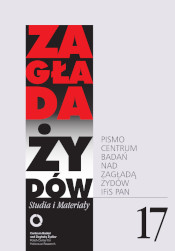

.jpg)
.jpg)


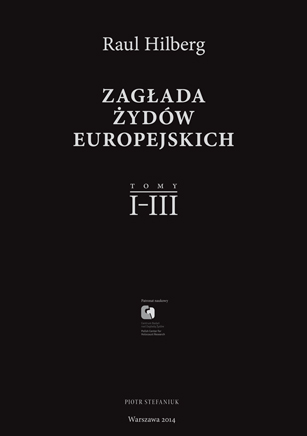
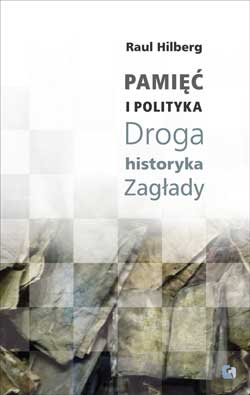
.jpg)
.jpg)
.jpg)
.jpg)
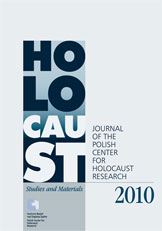

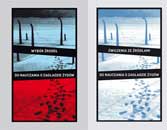
.jpg)
.jpg)
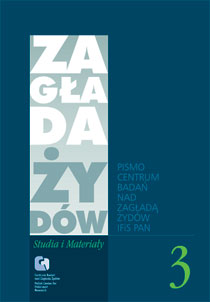
.jpg)
